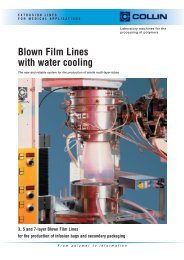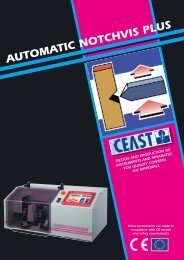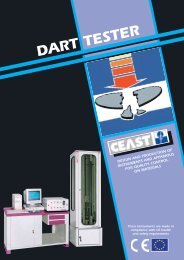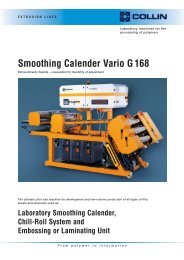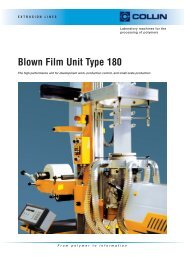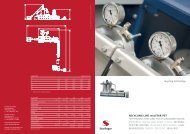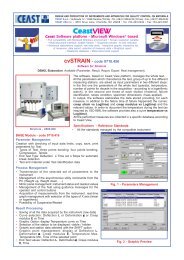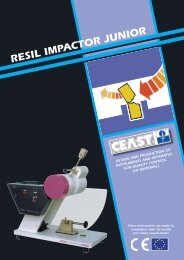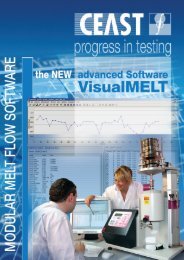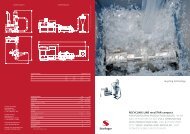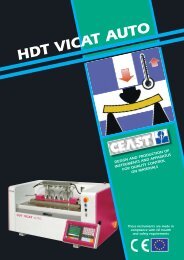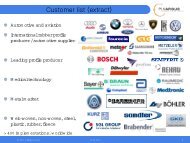FRACTOVIS PLUS
FRACTOVIS PLUS
FRACTOVIS PLUS
You also want an ePaper? Increase the reach of your titles
YUMPU automatically turns print PDFs into web optimized ePapers that Google loves.
DESIGN AND PRODUCTION OF<br />
INSTRUMENTS AND APPARATUS FOR<br />
QUALITY CONTROL OF MATERIALS<br />
<strong>FRACTOVIS</strong> <strong>PLUS</strong>
<strong>FRACTOVIS</strong> <strong>PLUS</strong><br />
code 7520.000, 7521.000,<br />
7525.000, 7526.000<br />
SCOPE<br />
The impact test is one of the most important<br />
mechanical tests on a material and serves to establish<br />
an understanding of the applicable “enduse”<br />
conditions.<br />
“End-use” refers to the performance of the finished<br />
product or component and not the basic resin pellet.<br />
In particular, among the destructive mechanical<br />
characterizations of plastic products, the response of<br />
the component to impact conditions is just one of the<br />
several considerations to determine material behaviour<br />
and engineering application.<br />
To perform impact tests with an energy rate higher<br />
than that obtainable using the pendulum, to break<br />
different specimen shapes or finished products, a drop<br />
weight instrument is necessary.<br />
Therefore Ceast, leading the design of impact test<br />
instruments for fifty years, has improved its line of<br />
sturdy and flexible dart drop testers with the new<br />
“Fractovis Plus”.<br />
View of Fractovis Plus<br />
FIELDS OF APPLICATION<br />
The new Fractovis Plus can perform :<br />
• Coupon tests in order to carry out Charpy, Izod and<br />
Tensile Impact tests<br />
• Biaxial impact tests on films, sheets, plates and pipes<br />
in accordance with the standards<br />
• Component tests and impact tests on finished<br />
products (glass, helmets, bumpers, etc.) as the<br />
component design and the shape can influence the<br />
brittle or ductile performance of the material<br />
• Non-instrumented and instrumented impact tests on<br />
specimens of different materials (polymers, ceramics<br />
and composites).<br />
NEW CONCEPT OF MODULARITY<br />
A main novelty of the “Fractovis Plus” is the “Upgrade”<br />
concept. In fact the instrument is pre-wired for easy<br />
connection of all options at a later date.<br />
Impact test on finished products with<br />
interchangeable special striker<br />
STANDARDS<br />
Designed and built to meet the following standards:<br />
ISO 179-2, ISO 180, ISO 3127, ISO 6603-1, ISO 6603-2,<br />
ISO 7765-1, ISO 7765-2, ASTM D 256, ASTM D 2444,<br />
ASTM D 3763, ASTM D 5628, ASTM D 6110,<br />
ASTM E 23<br />
and others equivalent.
STRIKERS<br />
A variety of interchangeable strikers available to meet<br />
standard test specifications and custom applications<br />
BASIC FEATURES<br />
Ceast instruments are characterized by their versatility<br />
and their user-friendly interface.<br />
The “Fractovis Plus” improves the user-machine<br />
interface in terms of simplicity with the new control panel<br />
so that the operator can manage the instrument to<br />
perform tests without any PC. This panel, equipped with<br />
a LC display and a soft-touch keyboard, provides instant<br />
access to the most widely used impact testing functions,<br />
including start/stop and reset drop position.<br />
The test execution is fully automatic controlled by<br />
microprocessor. It is possible to run an Autocheck<br />
sequence at any time to check the instrument. All<br />
calibration parameters can be edited using the keyboard.<br />
The speed detection system, in order to record the<br />
striker speed just before the impact event, and the<br />
specimen clamping system, in order to clamp,<br />
automatically, rigid plastic specimens, are basic features<br />
of all the “Fractovis Plus” line.<br />
Fractovis Plus offers also different types of strikers.<br />
Statistical elaboration example of Non-Instrumented<br />
test according to ISO 6603-1 method B<br />
NON-INSTRUMENTED TEST<br />
Non-instrumented impact tests are able to provide<br />
information on the quality behaviour of the material<br />
under the impact of a striker applied on the specimen.<br />
INSTRUMENTED TEST<br />
Instrumented impact tests provide full details of the<br />
impact event, from initial contact to final failure of the<br />
specimen by recording the force/time curve of the<br />
entire impact event.<br />
Instrumented impact technology is able to provide a<br />
valid method to evaluate the fracture toughness of a<br />
material; in fact, in accordance with linear elastic fracture<br />
mechanics and elastic-plastic fracture mechanics, it is<br />
possible to evaluate the energy release rate, respectively<br />
G IC and J c , intrinsic property of a material, which<br />
provides the most meaningful data to be used in the<br />
design of real components.<br />
Example of Instrumented test curves<br />
POSSIBILITY TO CHOOSE LOAD CELL SENSOR<br />
SAFE<br />
Due to the high energy involved during a test, Ceast<br />
has taken particular care of the safety features within<br />
the Fractovis. Micro-switches and protective circuits<br />
ensure that the operator performs the test in totally safe<br />
conditions. The instrument is built to comply with CE<br />
safety directives.<br />
Strain gauge striker<br />
Piezoelectric striker
Adjustable height support and pneumatic clamping<br />
plate for pipes or similar finished products<br />
<strong>FRACTOVIS</strong> <strong>PLUS</strong> STRENGTH<br />
The Ceast Fractovis Plus is characterized by:<br />
• Basic version pre-wired for easy connection of all<br />
options at a later date<br />
• Automatic striker recovery system to ensure high<br />
speed and high accuracy repositioning<br />
• Environmental chamber air circulation system in order<br />
to guarantee turbulent air flow and to provide<br />
uniform temperature distribution<br />
• Fully automatic test execution controlled by CPU to<br />
provide highest level of flexibility, to manage the<br />
geometrical test parameters (striker and specimen<br />
dimensions), to control each test function<br />
(anti-rebound system, clamping device, striker<br />
lubrication, etc.) and to run the whole test in fully<br />
automatic mode<br />
• User friendly man-machine interface with hierarchic<br />
menus and scroll lists<br />
• Improved user accessibility to the test area in order to<br />
facilitate specimen positioning<br />
• Anti-rebound system to prevent multiple impacts on<br />
the specimen; the system can catch the maximum<br />
applicable weight at the highest impact speed,<br />
preventing a second impact<br />
• Striker holder designed to guarantee maximum rigidity,<br />
easier mass application and quicker striker change<br />
• Reliable mass release system, according to Ceast<br />
tradition, with redundant sensors for maximum<br />
operator safety<br />
• Removable panels for easier maintenance operations<br />
Example of custom made clamping device<br />
OPTIONS<br />
• Automatic weighing system to self-identify the mass<br />
(load) applied on the striker<br />
• Automatic striker lubrication system<br />
• Special supports in order to carry out Charpy, Izod and<br />
Tensile Impact tests, pipe tests and a wide set of<br />
supports to carry out tests on film and sheet according<br />
to ISO and ASTM standards<br />
• Pivoting specimens loader to test 10 specimens in<br />
rapid sequence<br />
• Automatic specimen feeding system in order to<br />
perform tests in automatic cycle. This system has<br />
been designed to meet the ever increasing demand for<br />
automation from laboratories involved in intensive<br />
research and quality control testing on material at a<br />
rate between 60 and 120 tests per hour.<br />
Pivoting support which can be rotated without<br />
opening the chamber door
MAIN CHARACTERISTICS and OPTIONS<br />
Code<br />
7520.000<br />
Main Characteristics<br />
7521.000 7525.000 7526.000<br />
Drop height range [mm]<br />
Mass range [kg]<br />
30 ÷ 1100<br />
2 ÷ 70 (step 1 kg)<br />
Speed range [m/s]<br />
0.75 ÷ 4.6<br />
Maximum speed with additional energy system [m/s] (option)<br />
24<br />
Energy range [J]<br />
0.6 ÷ 755<br />
Maximum energy with additional energy system [J] (option)<br />
1800<br />
Test chamber inner dimensions Without thermostatic chamber 520 x 550 x 430 - 720 x 750 x 630 -<br />
(WxDxH) [mm]<br />
With thermostatic chamber<br />
350 x 350 x 300<br />
550 x 550 x 500<br />
Specimen clamping system<br />
Included<br />
Speed detection system<br />
Included<br />
Test execution<br />
Fully automatic, controlled by microprocessor<br />
Man-machine interface<br />
Display and keyboard (optional PC connection)<br />
Options<br />
Additional energy system<br />
Thermostatic chamber<br />
■<br />
■<br />
Antirebound system<br />
Striker lubrication system<br />
Automatic weighing system<br />
Light striker holder (2 to 6 kg)<br />
Heavy striker holder (6 to 70 kg)<br />
Fixed height support<br />
Adjustable height support<br />
Pivoting specimens loader<br />
- -<br />
Automatic specimen feeding system - -<br />
Technical Data<br />
Overall dimensions without Without thermostatic chamber 2650 x 905 x 720 - 2650x1065x850 -<br />
additional energy (WxDxH) [mm] With thermostatic chamber<br />
2650 x 905 x 850<br />
2650 x 1065 x 1150<br />
Overall dimensions with Without thermostatic chamber 3100 x 905 x 850 - 3100x1065x850 -<br />
additional energy (WxDxH) [mm] With thermostatic chamber<br />
3100 x 905 x 850<br />
3100 x 1065 x 1150<br />
Weight without additional energy Without thermostatic chamber 500 -<br />
600 -<br />
[kg]<br />
With thermostatic chamber<br />
550<br />
660<br />
Weight with additional energy Without thermostatic chamber 600 -<br />
700 -<br />
[kg]<br />
With thermostatic chamber<br />
650<br />
750<br />
Supply<br />
Power [W]<br />
Paint<br />
■ Included<br />
Optional<br />
Without thermostatic chamber<br />
With thermostatic chamber<br />
230 V - 50 Hz – Singlephase<br />
(110 V - 60 Hz on request)<br />
800<br />
3500<br />
Grey RAL 7035 – Fuchsia RAL 4006
Single Test Curve<br />
SOFTWARE FOR INSTRUMENTED<br />
IMPACT TESTS<br />
Using the latest generation of Ceast Data Acquisition System,<br />
DAS 8000, instrumented strikers and dedicated software,<br />
D8EXTWIN, it is possible to generate the force/time curve of<br />
any impact event.<br />
Below are listed Ceast software options to be used with<br />
Fractovis Plus for easy management of instrumented tests<br />
and for their advanced elaboration:<br />
D8EXTWIN main module to manage instrumented impact<br />
tests and to analyze the results<br />
WLEFMHR to determine the stress intensity factor (K IC ) and<br />
the energy release rate (G IC ) at high test speed<br />
D8WFILT to analyze and eliminate plastic oscillation due to<br />
resonance vibrations<br />
D8WTTA to analyze impact test results performed at<br />
different temperatures in order to evaluate the fragility index<br />
DAS8CLW to perform instrumented striker static calibration.<br />
WLEFMHR Page<br />
CEAST S.p.A.<br />
These instruments are made<br />
in compliance with CE health<br />
and safety requirements<br />
www.ceast.com Via Airauda, 12 • 10044 Pianezza (TO) Italy<br />
Tel: (+39) 011.966.40.38 (10 lines) • Fax: (+39) 011.966.29.02<br />
E-MAIL: Int. Sales: InfoItaly@ceast.com<br />
Int. after sales: aftersalestech@ceast.com<br />
CEAST USA INC.<br />
www.ceast.com<br />
WLEFMHR MODULE<br />
Advanced software has been developed by Ceast R&D<br />
department in order to allow further analysis of instrumented<br />
impact results: WLEFMHR.<br />
This software can be considered as a tool for the evaluation<br />
of data that can be used for design applications.<br />
It is based upon a testing procedure developed by ESIS<br />
(European Structural Integrity society) TC4. A three point<br />
bending (SENB) specimen configuration, with a very acute<br />
notch, like a crack, is required for the test. The software is<br />
able to provide, automatically, the value of K IC (stress<br />
intensity factor) and G IC (energy release rate) elaborating the<br />
impact test results and provides, for R&D departments and<br />
institutes, an important tool for advanced analysis.<br />
"Due to the continuous development policy of CEAST's Research and Development Department, changes may be introduced without notice"<br />
4816 Sirus Lane • Charlotte - NC 28208<br />
Tel: 704-423-0042 • Fax: 704-423-0081<br />
E-MAIL: USA Sales: salesusa@ceast.com • USA Service: Keith@ceast.com<br />
AP7520-01 0503 - Pubblicità erremme2 - TORINO - Printed in Italy



